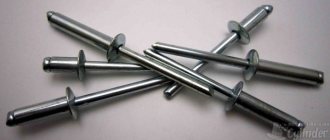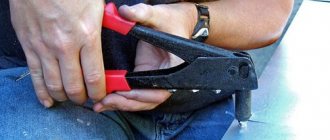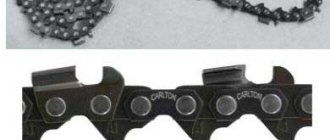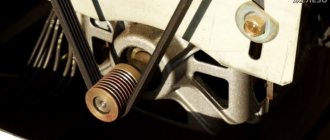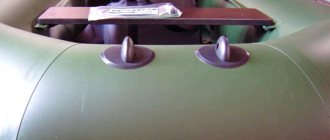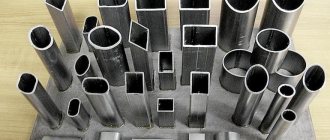Author of the article:
If we turn to the history of the development of the technical side of civilization, we must admit that the rivet is one of the most ancient inventions of mankind. The first rivets found by archaeologists as part of bronze elements of armor date back to the year 500 BC, and the first written mention of a rivet discovered in Egypt is more than three thousand years old.
And this is logical. The rivet is easy to use and has a long enough service life to satisfy the needs of any craftsman, it is universal and applicable in almost any field of human activity. In addition, the riveting algorithm assumes the deformation of soft metal - and it was with the use of low-melting soft metals that progress began.
Over a long time, the rivet has undergone a lot of changes and received many new variations, which have made it possible to introduce this hardware into new areas and industries, ranging from construction and mechanical engineering, to unexpected areas of application, for example, in the confectionery or clothing industry. One of the most common types of rivets is a blind rivet. This is a convenient hardware, suitable for cases where access to the parts being fastened is only on one side.
What is riveting
The mechanical connection of parts using a series of rivets is called riveting, and the connection itself is called a riveted seam. It is used where it is inconvenient to weld parts or where non-weldable materials are joined. Not only metals are riveted, but also parts in clothing, accessories, etc. are connected in this way. But there it is more of a finishing touch than a loaded connection. So next we will talk about riveting in construction or home improvement. In principle, you can use a screw connection instead of riveting, but bolts and nuts are more expensive, and their installation takes longer.
This is what a rivet joint looks like
If we talk about installing fences made of corrugated sheets, rivets are more reliable, since they can only be removed by drilling out the fasteners. When installing screws or self-tapping screws, they can be unscrewed and both metal and hardware can be removed. In some cases, riveting is more convenient when installing a roof made of corrugated sheets or metal tiles. On the roof, installing screw connections is problematic and time consuming. But rivets, and with a good tool, can be done in an hour or even less.
Most common use in private households
How are parts connected using rivets? The rivet is installed in the prepared through hole. It has a head that rests on the material and the rod. During the riveting process, the end of the rod is flattened, changing shape under the influence of force. Therefore, ductile metals are used for these hardware.
Types of blind rivets
The classification of blind rivets, as in the case of other hardware, is determined by the scope of their application, as well as the composition of the working material with which to deal. It is on these two factors that the understanding of how to make the right choice of a blind rivet when purchasing rests.
- Standard blind rivets. The principle of their operation was described above.
- Expansion rivets. It has an elongated sleeve that collapses when riveting, creating more material for fixation. This is very convenient if you need to fasten materials of different thicknesses and compositions.
- Reinforced blind rivets. They have a non-standard head shape, reminiscent of an arrowhead. This rivet provides a hermetically sealed connection with increased resistance to tension and lateral loads.
- Flap blind rivets. When riveting, the body of the hardware opens into petals that stick into the working surface, providing a large fixation area.
- Grooved blind rivets. Designed for blind holes. Applicable not only for metal, but also for wood.
- Closed blind rivets. They have a blind sleeve that envelops the head of the rod during operation, ensuring a completely tight connection.
- Multi-clamp blind rivets. The sleeve of such rivets is made of a softer metal than usual. The hardware is adjustable over a wide range, based on the thickness of the working material. The type of connection is aesthetic and pleasing to the eye.
Design
The fastener consists of two parts:
- Rod . At the end there is a thickening - a retainer for expanding the sleeve.
- Body . Consists of a head - a shoulder and a straight bushing.
Depending on the purpose, the head can be hidden. An ideal option when the hardware should be invisible on the surface of the material. Wide and high beads enhance the reliability of the connection, but are clearly visible to the naked eye. Not very aesthetically pleasing, but durable.
Rivets. How to calculate the required rivet length
Author of the article:
If we turn to the history of the development of the technical side of civilization, we must admit that the rivet is one of the most ancient inventions of mankind. The first rivets found by archaeologists as part of bronze elements of armor date back to the year 500 BC, and the first written mention of a rivet discovered in Egypt is more than three thousand years old.
And this is logical. The rivet is easy to use and has a long enough service life to satisfy the needs of any craftsman, it is universal and applicable in almost any field of human activity. In addition, the riveting algorithm assumes the deformation of soft metal - and it was with the use of low-melting soft metals that progress began.
Over a long time, the rivet has undergone a lot of changes and received many new variations, which have made it possible to introduce this hardware into new areas and industries, ranging from construction and mechanical engineering, to unexpected areas of application, for example, in the confectionery or clothing industry. One of the most common types of rivets is a blind rivet. This is a convenient hardware, suitable for cases where access to the parts being fastened is only on one side.
How to choose rivet material?
One of the main selection criteria is the material from which the fastener will be made.
Rivets can be:
- Aluminum, resistant to corrosion, tolerates chemically aggressive environments well, can be used as decorative elements (lacquered aluminum), used for fastening materials of external structures or in units exposed to aggressive environments;
- Stainless steel, not susceptible to corrosion and aggressive environments, used for the food industry, external structures and chemical plants;
- Galvanized, not subject to corrosion, can be used for many types of designs on the streets, as well as for units in difficult operating conditions;
- Made from polyamide or plastic, this fastening option is suitable for bendable sheet material;
- Copper, ideal for installing copper roofing, as well as elements of façade structures , are resistant to corrosion, are non-toxic, and are very durable;
- Colored, ready for painting, everything is simple here, the products are ideal for painting, and the paint will not peel off for a long time.
Advantages and disadvantages of different riveters
The fact that there are several types of riveters on the market is due to the presence of both pros and cons of their use.
Based on them, the tool is selected for work in specific conditions:
- • One-handed models develop a small working force, so they are used for installing rivets made of soft material, such as aluminum. At the same time, they are compact and require only one hand to operate.
- • Two-handed models, due to the presence of two reinforced levers, can easily cope with rivets made of hard material, such as steel. At the same time, the work is performed with two hands, which is somewhat inconvenient.
- • Rocker models support one-handed operation. The force can be increased by leaning on the mechanism with your whole body, which also provides support for the steel rivets.
At the same time, the accordion is not suitable for installing lightweight structures that cannot withstand the high pressure exerted on them required to tighten the fasteners.
Operating principle
Blind rivets consist of a sleeve, inside of which there is a rod with a seal at the end. In technical language, this seal is called a punch. During the riveting process, pressure is applied to the rod, causing the punch to deform the end of the rod into something like a head. At the same time, the sleeve itself also expands, fixing the attachment point.
Working with rivets is characterized by a relatively high speed, which can be considered an advantage of this hardware. Rivets are always treated with various compounds that are resistant to aggressive environments, high humidity and temperature changes, which increases their service life.
Installation process
The algorithm for installing a threaded element can hardly be called overwhelming, but it is important to know certain nuances. If possible, it is better to use a factory riveter
If desired, you can assemble it yourself; one option will be discussed below. The first step is to determine the type of metal on which the rivet will be installed. Next, you need to know what the diameter of the bolt or module that will be fixed thanks to this rivet is. According to the specified diameter, the appropriate rivet is selected. Its outer diameter is measured and a drill is selected that will be one tenth in diameter larger than the rivet. This is necessary so that the latter fits into place without much effort or obstacles.
Electric or cordless drill. The metal is drilled in the required location. After this, the fastening element is inserted into the seat. If it needs to be placed in a certain position, then it is better to hold it with your hands. For hexagonal holes, you can use special punches if we are talking about thin metal. If the thickness of the metal is greater than the length of the fastener, then the hole must be drilled a little deeper than the fastener, but there is no need to make a through penetration. After this, a rivet maker core is selected that fits the thread to the element being installed. The handles are brought together or the bolt is rotated so that part of the rivet is deformed and fixed in the hole.
You should not apply too much force, as you can tear off the thread, which will later be used to fix the required part. It is necessary to ensure that the rivet is installed in the required position. After this, you can fix the required product using a screw or bolt.
Operating principle of a hammer rivet
A classic hammer rivet is a rod with a rivet head of a certain shape (semicircular, countersunk, semi-countersunk, flat). The closing head is formed from the opposite end of the rod by plastically deforming it using a riveting hammer and a special impact mandrel, which gives the head a neat semicircular shape. In this case, massive support must be provided from the side of the mounting head. Obviously, to install such a rivet it is necessary to have access from both sides of the surfaces being fastened.
Determining the length of a rivet with a closing head
To correctly install the rivet fastener, it is important to accurately select its length so that it is possible to create a closing head of the required shape from the protruding part of the rod and obtain a connection without gaps. The length of hammer rivets produced varies from 2 to 180 mm and is selected based on the thickness of the package of materials being fastened. First you need to determine the length of the protruding part of the rod (allowance). For the version with a semicircular head, the allowance is 1.2...1.5d, and for the version with a countersunk head - 0.8...1.2d, where d is the diameter of the rod. Based on the obtained allowance value, it is easy to calculate the total length of the rod by adding to it the thickness of the materials being riveted - S.
Types of rivet seams
If we talk about the method of joining sheets, then riveted seams can be overlapped (one sheet overlaps another) and end-to-end. Joint seams can have one or two overlays. With overlays they are more reliable and are used in critical and loaded places.
Types of rivet seams: overlapped and butted with overlays
According to the location of the rivets:
- single row;
- double row;
- multi-row.
They can be located opposite each other or in a checkerboard pattern. Seams can be strong, tight (sealed) or durable-tight. Dense ones are made using elastic gaskets placed between the parts to be connected. Durable and dense ones are used mainly in boilers. Now they are more often replaced by welding.
Threaded rivets and their types
Threaded rivets are often called nut rivets, internally threaded rivets, nut rivets or bolt rivets. Rivets of this type are a sleeve with an internal thread made approximately half the length and a small flange (side) necessary for reliable fastening of the rivet in the metal. Such rivets are made from various materials such as galvanized steel, stainless steel, aluminum alloys and EPDM rubber. In addition to the material, threaded rivets differ in the diameter of the thread, as well as the shape of the body and the type of flange.
Purpose
The purpose of nut rivets is to create a thread in metal whose thickness can be from 0.3 mm to 6.0 mm, for subsequent connection of parts using screws or bolts.
Installation of threaded (nut) rivets
To install threaded rivets correctly, a special tool called a thread riveter is used. The threaded rod of the riveter is screwed into the nut rivet and the rivet is placed in a pre-prepared hole in the base material. (The diameter of the hole depends on the size of the rivet and is determined from the catalog src=»https://krepmix.ru/upload/library/554/55455cc59e562b1862996d9fc4d5b627.png» class=»aligncenter» width=»672″ height=»457″[/img ]
Next, the threaded rod is pulled into the body of the rivet gun and the part of the rivet that does not have an internal thread is deformed, reliably fixing the rivet in the hole. (The length of the rivet is selected according to the manufacturer’s catalog depending on the thickness of the material in which it needs to be installed)
After installation, the threaded rod of the riveter is unscrewed from the rivet, and the installation process is completed.
Main advantages of threaded rivets
- Using nut rivets, you can create threads in thin sheets of metal with a thickness of 0.3 mm, while access to the installation site of the rivet is needed only from one side, which allows them to be used to create threads in various hollow profiles and pipes.
- Installation of such rivets occurs completely mechanically without the use of welding.
- If it is necessary to paint parts in which threads need to be created, nut rivets can be installed after painting, which eliminates unnecessary operations in production to clean the threads or protect them before painting.
- Maintainability: if the thread in a rivet is damaged, then such a rivet can be replaced by drilling with a drill of the same diameter as the hole for this rivet.
Rivet thread diameters
Nut rivets are manufactured with metric threads M3, M4, M5, M6, M8, M10 and M12 with standard pitch.
Body shapes of threaded rivets
Cylindrical
The most common type of threaded rivets are smooth without notches and with notches, a special corrugation located along the body of the rivet and preventing it from turning. Installed in a round hole of a certain diameter.
Hexagonal and half-hexagonal
Rivets with this body shape are used in places where it is necessary to prevent the possibility of turning the rivet during operation. To install the rivet correctly, the hole in the metal must have a hexagonal shape.
Deaf (closed)
Closed threaded rivets protect the threads and the inside of the product from liquids and dirt; blind rivets are cylindrical, hexagonal and half-hexagonal.
Petalaceae
Used for installation in soft or brittle materials such as plastic. Due to their shape, they form a much larger area of contact with the base than standard threaded rivets.
Aluminum rivets with a semicircular head GOST 10299-80 weight 1 piece per g. tab. 2
| Length, mm | Rivet diameter, mm | |||||||
| 14 | 16 | 18 | 20 | 22 | 21 | 30 | 36 | |
| 20 | 13,923 | 18,985 | ||||||
| 22 | 14,785 | 20,110 | ||||||
| 24 | 15,643 | 21,235 | ||||||
| 26 | 16,504 | 22,357 | ||||||
| 28 | 17,366 | 23,482 | 30,641 | |||||
| 30 | 18,224 | 24,607 | 32,065 | |||||
| 32 | 19,085 | 25,728 | 33,485 | |||||
| 34 | 19,947 | 26,853 | 34,909 | 44,215 | ||||
| 36 | 20,805 | 27,978 | 36,348 | 45,960 | ||||
| 38 | 21,666 | 29,099 | 37,750 | 47,704 | 61,018 | |||
| 40 | 22,528 | 30,224 | 39,160 | 49,484 | 63,119 | 80,527 | ||
| 42 | 23,386 | 31,349 | 40,584 | 51,228 | 68,459 | 83,055 | ||
| 45 | 24,678 | 33,037 | 42,720 | 53,863 | 71,627 | 86,864 | ||
| 48 | 25,970 | 34,721 | 44,856 | 56,497 | 73,763 | 90,638 | ||
| 50 | 26,828 | 35,849 | 46,280 | 58,242 | 75,864 | 93,201 | ||
| 52 | 27,690 | 36,953 | 47,704 | 60,022 | 79,068 | 95,728 | ||
| 55 | 28,978 | 38,662 | 49,840 | 62,656 | 82,272 | 99,502 | 164,721 | 256,213 |
| 58 | 30,271 | 40,335 | 51,976 | 65,255 | 84,372 | 103,454 | 171,414 | 264,757 |
| 60 | 31,132 | 41,474 | 53,400 | 67,035 | 89,676 | 105,839 | 174,618 | 270,453 |
| 65 | 33,282 | 44,286 | 56,960 | 71,414 | 95,016 | 112,140 | 184,479 | 284,658 |
| 70 | 35,433 | 47,063 | 60,520 | 75,828 | 100,321 | 118,477 | 194,376 | 298,898 |
| 75 | 37,594 | 49,876 | 64,080 | 80,207 | 105,625 | 124,778 | 204,237 | 313,102 |
| 80 | 39,730 | 52,688 | 67,640 | 84,586 | 110,930 | 131,115 | 214,134 | 327,378 |
| 85 | 41,901 | 55,500 | 71,200 | 89,000 | 116,234 | 137,416 | 223,995 | 341,546 |
| 90 | 44,037 | 58,313 | 74,760 | 93,379 | 121,574 | 143,753 | 233,892 | 355,786 |
| 95 | 46,173 | 61,125 | 78,320 | 97,758 | 126,878 | 150,090 | 243,753 | 369,991 |
| 100 | 48,345 | 63,938 | 81,880 | 102,172 | 137,487 | 156,391 | 253,614 | 384,231 |
| 110 | 52,652 | 69,562 | 89,000 | 110,930 | 148,132 | 169,029 | 274,084 | 412,675 |
| 120 | 56,960 | 75,187 | 96,120 | 119,723 | 158,740 | 181,667 | 293,130 | 441,120 |
| 130 | 61,232 | 80,776 | 103,240 | 128,480 | 169,349 | 194,305 | 312,888 | 469,564 |
| 140 | 65,540 | 86,415 | 110,360 | 137,274 | 179,994 | 206,978 | 332,646 | 498,008 |
| 150 | 146,031 | 190,674 | 219,616 | 352,404 | 526,453 | |||
| 160 | 154,824 | 201,247 | 232,254 | 372,162 | 554,897 | |||
| 170 | 211,856 | 244,892 | 391,920 | 583,342 | ||||
| 180 | 257,530 | 411,643 | 611,786 |
What other points do you need to pay attention to?
To choose the right rivet, you will need to take into account such points as:
- Rivet tensile and shear strength;
- Interaction between the materials being fastened and the material from which the rivet was made. The best option is always to take the same materials. For example, to avoid the formation of a galvanic couple;
- Geometric parameters of the rivet, as well as some other points that relate to particularly specialized cases.
Each of these points deserves a separate detailed consideration, but within the framework of this article it is simply impossible to pay attention to everything.
So, following the above recommendations, it will be possible to ensure a high-quality and durable connection using correctly selected blind rivets.
Before the purchase
The use of rivets is always determined by three important nuances. Firstly, the strength of the connection plays a paramount role. Secondly, check what equipment you have and what components are suitable for it. And thirdly, understand the economic feasibility of the work and planned purchases
In any activity, no matter what materials you fasten and no matter what connectors you use, it is always important to remember that any rivet material has its own viscosity and plasticity, on the basis of which the algorithm for the operation of such a connection is based. Rivets are ALWAYS made of copper, low-carbon steel or aluminum alloys that are easily deformed
Carefully study the types of rivets when planning your work.
Threaded rivets
Let's move on to threaded rivets. Working with them is the most universal way to connect the constituent elements of a structure. The types of threaded rivets are varied, but the essence is the same. The algorithm is simple and ingenious: the rivet is screwed onto the “mandrel” of the riveter, inserted into the hole, and fixes the materials to be joined. In this case, the rivet is deformed, forming a reliable connection that firmly holds the individual parts during vibration and movement. The most important advantage is the low probability of damage to the parts being connected during riveting, which experience virtually no stress, are not scratched or wrinkled. Therefore, threaded rivets are used in household appliances, car cladding and interior decoration. Such components are made of aluminum, steel, and stainless steel. Types of threaded rivets, their features and composition are always indicated on the packaging.
Blind rivets
Another well-known type of rivets is blind rivets. They are cheaper than threaded ones, they are easier and faster to deal with, because they are used where it is necessary to secure a sheet of metal with hundreds or even thousands of rivets. Types of blind rivets differ mainly in the model of the collar. This is the name given to the edges of the “cap” located on the body of the rivet. Different types of blind rivets are usually made of steel, stainless steel, aluminum, and copper. Unlike the previous type, the sleeve is deformed thanks to a rod that is pressed into the sleeve, forming a rigid connection. The main advantage of these components is their high speed and ease of operation.
Regular rivets
The classic rivet is the most common hardware for riveting metal sheets, known since ancient times. In our country, driven rivets were fixed by GOST requirements back in the Soviet years. They are widely used in construction and in general in all areas associated with the presence of high loads on metal structures, since such rivets can connect sheets thicker than 30 mm. However, installation of these hardware is only possible taking into account the presence of support on the side opposite the plane of the connection, since this compensates for the impact load during fastening of the rivet.
The algorithm of actions is as follows:
- Future connections are being outlined.
- Sheet material is fixed with clamps or other means. Sometimes welding takes place. The extreme points are drilled first. The rivets are inserted so that the head is on the opposite side of the surface being joined.
- Actually, the process of riveting itself using a hammer or a special striker, in which the shank is flattened into a second head.
During the process, be sure to check with GOST, since a rivet body that is too thin may not completely fill the hole, which can lead to breakage of the connections under a cutting lateral load. A shank that is too long can also damage the structure, as the metal will be subject to improper deformation. There are brands of rivets that must be heated to a high temperature to increase ductility. Also, many rivets are treated with special compounds that prevent electromechanical corrosion. Please read the packaging carefully before purchasing.
Selection of rivet sizes
Rivets are selected based on the thickness of the metals being connected. The following are important: the parameters of the embedded head and the diameter of the rod. The diameter of the rod determines the diameter of the drill, which is used to prepare a hole in the parts to be joined. You can approximately determine the diameter of the rivet by doubling the thickness of the parts being connected. The length of the rod is at least 2 times the diameter of the rivet, and the protruding part must be at least 1.25-1.5 times the diameter.
| Rivet diameter | 2.0 mm | 2.3 mm | 2.6 mm | 3.0 mm | 3.5 mm | 4.0 mm | 5.0 mm | 6.0 mm | 7.0 mm | 8.0 mm |
| Hole diameter for precision assembly | 2.1 mm | 2.4 mm | 2.7 mm | 3.1 mm | 3.6 mm | 4.1 mm | 5.2 mm | 6.2 mm | 7.2 mm | 8.2 mm |
| Rough hole diameter | 2.3 mm | 2.6 mm | 3.1 mm | 3.5 mm | 4.0 mm | 4.5 mm | 5.7 mm | 6.7 mm | 7.7 mm | 8.7 mm |
In general, the diameter of the rivet rod can be from 1 mm to 36 mm, and its length can be from 2 mm to 180 mm. Moreover, a larger diameter does not equate to greater joint strength. Here, both the material from which it is made and its type (hollow or solid) play a role. How to choose? According to the characteristics of the rivets. After all, you choose them to connect certain materials of a certain thickness. You also know approximately the load that will be applied to the connection. Therefore, when selecting, pay attention to what the manufacturer recommends.
How to select a rivet according to the thickness of the material being fastened? According to the manufacturer's instructions, but in general, the diameter of the rod should be at least twice the thickness of the materials
Must be indicated:
- Recommended diameter for connection. All you have to do is select a drill and make a smooth hole without burrs.
- Minimum and maximum thickness of the connected package. It is important that your connection is within the specified range.
- Shear force. This is the load applied perpendicular to the connection that the rivet can withstand without destruction.
- Breaking force. Under what load along the rivet will it fail?
It is the tensile and shear forces that determine the strength of the future seam. The higher these values, the greater the load it will withstand.
When length matters
Let us repeat, pointing out the importance of such a parameter as length. The correct formation of the closing head and the tightness of the connection depend on it. Excessive length here will be just as harmful as its lack. Against this background, the task of calculating the optimal length of connecting elements is important.
How to calculate the length. The formula is simple and therefore, before starting work, we recommend making these simple calculations, taking into account the following abbreviations:
S is the total thickness of the parts being connected;
d—diameter;
L is the required length.
Example: we have two parts with a thickness of 10 and 15 mm. The calculated diameter of the rivets is 4 mm. According to the formula: L = S+1.2d we have - 10+15+1.2*4 = 26.8 mm.
In this formula, “1.2” is a correction factor.
Its value depends on:
- head shape;
- material;
- heat treatment.
For domestic use, we calculate the length of the rivets using a coefficient of 1.2. In this case, it can be accepted as average and optimal.
Table 1 will help you choose the closest standard size for diameter 4. We get 30 mm.
The science of “Strength of Materials” recommends placing blind rivets (and others) at a distance of no closer than five diameters from each other. Let us add that there are special formulas for calculating fasteners for shearing and crushing of heads. Such calculations are made when designing quite important structures, and they are practically not used in everyday life.
Application
The variety of areas for using blind rivets, as already mentioned, tends to infinity. But it is still possible to identify the main industries in which this hardware has become traditional.
- Electronics and energy.
- Consumer goods of the widest profile. From complex mechanics to simple objects with a composite structure.
- Mechanical engineering.
- Construction, in the broadest sense, starting from the connection points of supporting structures and ending with interior decoration (including interior decoration).
Pull and pull rivet
Sometimes in the description of a rivet you can find the name “traction”. It's still the same blind rivet without any changes. Apparently, the old name was preserved from those times when there was no unified tool for blind rivets. The rod was pulled out using improvised means, for example, pliers. This type of connection is sometimes used today, but it does not provide good fixation. It is recommended to use rivet guns, which are inexpensive and available in every hardware store.
